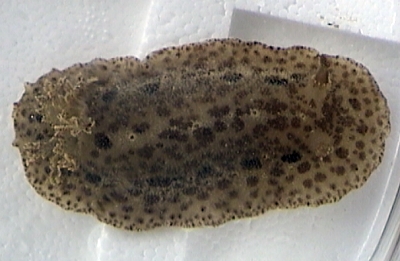
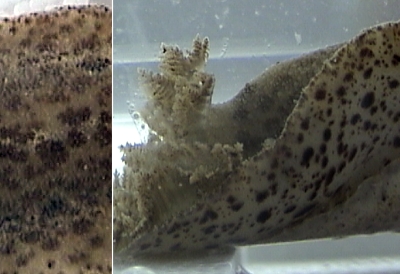
Discodoris maculosa
Bergh, 1884
Order: NUDIBRANCHIA
Suborder: DORIDINA
Family: Dorididae
DISTRIBUTION
Mediterranean Sea
PHOTO
From coastal lagoon, Lac de Tunis [south section], Tunis, Tunisia, North Africa. Depth: 0 to 1m some time between January and March, 2003. Photo: Jamila Ben Soussi
This is one of a group of reasonably large brown-spotted dorids found in the eastern Atlantic-Mediterranean region. Some of them have been apparently mistaken for the Indo-West Pacific species, Discodoris lilacina, also know as D. fragilis. They have been previously placed on the Forum as Discodoris cf. lilacina.
Discodoris maculosa was first described from Naples and has since been reported infrequently from various parts of the Mediterranean. It is difficult to be sure of all records because there is still confusion surrounding the identity of these brown-spotted dorids. Probably the largest sample studied is that of Schmekel & Portmann (1982) who based their description on 36 specimens from the Naples region.
This species is a large brown dorid with a pale background colour and many, relatively small, roundish brown spots. There are often a few small dark brown, almost black spots, forming a line down the midline of the mantle between the gills and the rhinophores, and also around the mantle edge. These spots are usually surrounded by a whitish ring and can be clearly seen in the upper photo. Similar dark spots surrounded by white can be found in the Indo-West Pacific D. lilacina.
Another characteristic external feature are the closely spaced soft, cone-shaped tubercles covering the mantle. As Ballesteros et al (1985) describe, this is quite different from the scattered tubercles of D. confusa. These authors consider Discodoris maculosa and D. confusa differ from D. lilacina in details of the reproductive system and radular morphology.
-
Ballesteros, M., Llera, E.M., Ortea, J.A. (1985) Revision de los Doridacea (Mollusca: Opisthobranchia) del Atlantico Nordeste atribuibles al complejo maculosa-fragilis. Bolletino Malacologico, 20: 227-257.
- Bergh, L. S. R. (1884) Malacologische Untersuchungen. In: C.G. Semper, Reisen im Archipel der Philippinen, Wissenschaftliche Resultate. Band 2, Heft 15: 647-754, Pls 69-76.
-
Schmekel, L. and Portmann, A. (1982) Opisthobranchia des Mittelmeeres, Nudibranchia und Saccoglossa. Fauna Flora Golfo Napoli 40: 1-410.
Rudman, W.B., 2006 (November 30) Discodoris maculosa Bergh, 1884. [In] Sea Slug Forum. Australian Museum, Sydney. Available from http://www.seaslugforum.net/find/discmacu
Related messages
Re: Jorunna tomentosa from Tunisia
July 28, 2003
From: Jamila Ben Soussi
Note added 30 Nov. 2006: I have today moved this species to a new Discodoris maculosa Fact Sheet. See messages associated with that Fact Sheet and the one for D. confusa, for details.
Dear Bill
Concerning the species you tentatively identified as Jorunna tomentosa - after reading of the comments by Peter H. van Bragt and Alma Sanchez, it might help to say that this nudibranch, unlike the other species collected in the Southern lagoon of Tunis, is particularly very rough to the touch. Hopefully this detail can help with the determination.
Kindly,
Jamila Ben Soussi
bensouissi.jamila@inat.agrinet.tn
Ben Soussi, J., 2003 (Jul 28) Re: Jorunna tomentosa from Tunisia. [Message in] Sea Slug Forum. Australian Museum, Sydney. Available from http://www.seaslugforum.net/find/10554Dear Jamila,
Yes that does help. As Peter and Alma suggested, it seems your animal is a species of Discodoris. I am afraid we can't really confirm what species it is until we have a better idea of the relationship between those found in the Atlantic and the Indo-West Pacific.
Best wishes,
Bill Rudman
Re: Jorunna tomentosa from Tunisia
May 27, 2003
From: Alma Sanchez
Note added 30 Nov. 2006: I have today moved this species to a new Discodoris maculosa Fact Sheet. See messages associated with that Fact Sheet and the one for D. confusa, for details.
Dear Dr. Rudman,
I think the dorid from Tunisia is not Jorunna tomentosa but probably a species belonging to the genus Discodoris. It seems to me that could be Discodoris maculosa, Bergh 1877 or another species belonging to complex “maculosa-fragilis”.
Best wishes,
Alma
almasanchez83@hotmail.com
Sanchez, A., 2003 (May 27) Re: Jorunna tomentosa from Tunisia. [Message in] Sea Slug Forum. Australian Museum, Sydney. Available from http://www.seaslugforum.net/find/9899Thanks Alma,
I wasn't very confident in calling it Jorunna tomentosa and must admit the the row of ringed spots down the mantle midline did remind me of the Indo-West Pacific Discodoris lilacina. I have started a page for Atlantic Discodoris 'lilacina-fragilis' until we can get their identity resolved.
Best wishes,
Bill Rudman
Re: Jorunna tomentosa from Tunisia
May 27, 2003
From: Peter H. van Bragt
Note added 30 Nov. 2006: I have today moved this species to a new Discodoris maculosa Fact Sheet. See messages associated with that Fact Sheet and the one for D. confusa, for details.
Hello Anis and Bill,
I personally have some doubts about the specimen from Tunisia being Jorunna tomentosa. At least along the Dutch coast all recent observed specimen are rather white with distinctive spots on the side. These spots are clearly a form of mimicry and look like the discharge channels of sponges on which it feeds. Also the overall velvet-like texture of the mantle is very much like the surface texture of a sponge. Also as you can see on my picture of J. tomentosa on the Forum there are only a few spots on each side. For all the mature specimen that I have seen these spots hardly ever exceed four per side. I personally do not recognise a J. tomentosa in this densely spotted specimen from Tunisia! Maybe other nudi-spotters from various other European regions may want to comment on this issue too.
Best regards
Peter H. van Bragt
vanbragt.phjm@hsbrabant.nl
van Bragt, P.H., 2003 (May 27) Re: Jorunna tomentosa from Tunisia. [Message in] Sea Slug Forum. Australian Museum, Sydney. Available from http://www.seaslugforum.net/find/10032Thanks Peter,
I agree with your comments and Alma's message and have moved it to a temporary page for Disodoris cf. lilacina from the eastern Atlantic.
Best wishes,
Bill Rudman
Jorunna tomentosa from Tunisia
May 8, 2003
From: Anis
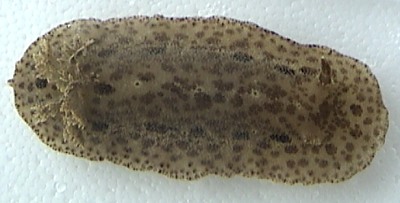
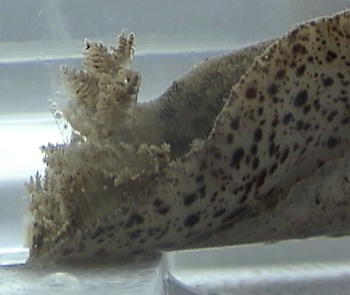
Note added 30 Nov. 2006: This is clearly not Jorunna and was moved to a Discodoris cf lilacina page within a few days of posting. I have today moved it to a new Discodoris maculosa Fact Sheet. See messages associated with that Fact Sheet and the one for D. confusa, for details.
Dear Bill,
I found this sea slug in a coastal lagoon, "Lac de Tunis" [south section] in Tunis, Tunisia, North Africa. Depth: 0 to 1m some time between January and March, 2003.
Can you identify it please.
Thanks,
Anis.
bensouissi.jamila@inat.agrinet.tn
Anis, 2003 (May 8) Jorunna tomentosa from Tunisia. [Message in] Sea Slug Forum. Australian Museum, Sydney. Available from http://www.seaslugforum.net/find/9684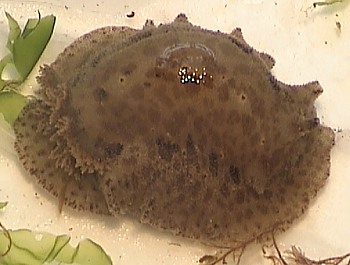
Dear Anis,
From the 'furry' texture of the mantle, and its colour pattern, I would tentatively identify this as Jorunna tomentosa. There are other species of Jorunna described from the region so some local feedback would be welcome.
Best wishes,
Bill Rudman
